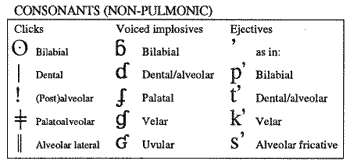
This is the main IPA consonant chart. (Clicking on a column will take you to the page for that place of articulation. Clicking on a row label will take you to the page for that manner of articulation.)

Given that we need to answer seven questions to describe a consonant, a perfect consonant chart would need seven dimensions. For us mere mortals who can't handle seven-dimensional diagrams, the IPA consonant chart uses several tricks to squeeze the answers to all seven questions into two dimensions.
In the horizontal dimension of the IPA consonant chart, each of the most common places of articulation (i.e., the most common combinations of active and passive articulators) has its own column:
| IPA column label |
active articulator |
passive articulator |
|---|---|---|
| bilabial | labial (lower lip) | labial (upper lip) |
| labiodental | labial (lower lip) | dental (upper teeth) |
| dental | apical/laminal | dental |
| alveolar | apical/laminal | alveolar |
| postalveolar | apical/laminal | postalveolar |
| retroflex | apical | postalveolar/palatal |
| palatal | dorsal | palatal |
| velar | dorsal | velar |
| uvular | dorsal | uvular |
| pharyngeal | radical | pharyngeal |
| glottal | (see page) | (see page) |
Note also the mega-column that covers dental, alveolar, and postalveolar for most of the height of the chart. The designers of the IPA thought it was worthwhile to make three real columns only for the fricatives. For all the other manners of articulation, a symbol in the mega-column, like [d], can represent a sound with any of the three places of articulation. For many languages this is good enough for a broad transcription. In those cases where you need to get more specific, you can add diacritics:
| dental | [ d̪ ] |
| alveolar | [ d̺ ] |
| postalveolar | [ d̠ ] (or else treat as retroflex [ ɖ ]) |
In the vertical dimension of the chart, each of the most common combinations of constriction degree, nasality, and laterality has a row of its own.
IPA row label |
laterality |
nasality |
constriction degree |
|---|---|---|---|
| Plosive | non-lateral |
oral |
stop |
| Nasal | non-lateral |
nasal |
stop |
| Trill | non-lateral |
oral |
trill |
| Tap or Flap | non-lateral |
oral |
tap or flap |
| Fricative | non-lateral |
oral |
fricative |
| Lateral Fricative | lateral |
oral |
fricative |
| Approximant | non-lateral |
oral |
approximant |
| Lateral Approximant | lateral |
oral |
approximant |
Only the two most common types of phonation (voiced and voiceless) are represented in the main IPA chart. If two symbols appear in the same cell (like [p] and [b]), the one on the left represents a voiceless sound (like [p]) and the one on the right a voiced sound (like [b]). Symbols that appear alone and pushed to ward the right (like [m]) also represent voiced sounds.
Airstream mechanism is not answered directly in the consonant chart. Every last one of the consonants in the main chart uses the most common airstream mechanism -- the pulmonic mechanism, as indicated in the title of the chart, "Consonants (pulmonic)". The sounds that use one of the less common airstream mechanisms are exiled to a smaller sub-chart (which appears directly below the main consonant chart if you have the all-on-one-page version).

The three non-pulmonic airstream mechanisms used in languages are clicks, voiced implosives, and ejectives.